- Introduction to Al Freeman
In this artist spotlight, we explore the captivating work of Brooklyn-based artist Al Freeman, known for her striking and humorous approach to everyday items. Freeman’s art goes beyond the ordinary, infusing banal objects with a playful sense of wit that challenges established gender norms and critiques consumer culture.

- Larger-Than-Life Puffy Pleather Reproductions
At the heart of Al Freeman’s artistic expression are her larger-than-life puffy pleather reproductions. Through her distinctive artistic lens, she transforms mundane items into captivating artworks. These reproductions, characterized by their exaggerated size and use of pleather, serve as a medium through which Freeman engages with her audience, prompting them to reconsider the ordinary in an extraordinary light.

- Poking Fun at Gender Norms and Consumerism
Freeman’s art serves as a poignant commentary on societal expectations and norms, particularly those related to gender. By playfully deflating traditionally masculine objects, she challenges the conventional notions of virility and invites viewers to question preconceived ideas. In this act of deflation, Freeman not only disrupts gender norms but also critiques the pervasive influence of consumerism on our understanding of identity.

- Academic Background and Representation
Al Freeman brings a rich academic background to her artistic practice. Having earned a Bachelor of Fine Arts (BFA) from Concordia University in Montréal in 2005 and a Master of Fine Arts (MFA) from Yale University in 2010, Freeman’s work is informed by a deep understanding of artistic principles and concepts. Represented by 56 Henry, her art has found a platform that allows her distinctive voice to resonate within the contemporary art scene.

- Conclusion: Al Freeman’s Artistic Impact
In the realm of contemporary art, Al Freeman stands out for her ability to inject humor and social commentary into her creations. By challenging gender norms and consumerist ideals through the lens of puffy pleather reproductions, she sparks conversations about identity, representation, and societal expectations. Al Freeman’s work serves as a testament to the transformative power of art, encouraging viewers to reconsider the familiar and question the constructs that shape their understanding of the world.





















